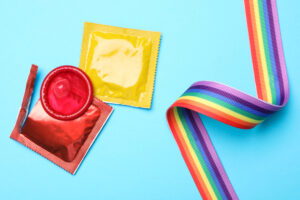Using male (external) condoms, female (internal) condoms, and dental dams correctly and consistently can reduce the risk of sexually transmitted diseases (STDs), including human immunodeficiency virus (HIV) and viral hepatitis.
Continue reading to learn about the types of condoms available, tips for using them correctly, and how to obtain free condoms.
Types of Condoms
There are three types of condoms:
Condom Effectiveness
Condoms are effective at preventing HIV and STIs spread by genital fluids. While condoms do not protect against STIs spread through skin-to-skin contact, such as human papillomavirus (HPV), genital warts, genital herpes, or syphilis, laboratory and epidemiological studies show that condoms are highly effective in preventing the spread of HIV and STIs transmitted through genital fluids, such as gonorrhea and chlamydia, when used correctly and consistently.
Condom Best Practices
The best way to protect yourself from HIV and other STIs (and pregnancy, if that’s a concern) is through consistent and correct condom use. STDs and HIV can be transmitted from just one sexual act with an infected partner if a condom breaks, slips, or leaks. Therefore, it is essential to learn how to use condoms correctly and consistently.
Here are some important tips:
- Always use a new condom for every act of vaginal, anal, or oral sex, and never reuse condoms.
- Read the condom package insert and check the expiration date.
- Store condoms in a cool, dry place.
- Check for tears or defects in the condom before each use.
- Do not use a male (external) condom with a female (internal) condom, as this can cause tearing.
- Avoid stretching condoms, as this can also lead to tearing.
- Use water-based lubricants to help prevent the condom from slipping and tearing. Oil-based lubricants (like petroleum jelly and body lotions) can weaken latex and break the condom.
- When using a dental dam, avoid nonoxynol-9 (a spermicide), as it can cause irritation.
- If you feel the condom break at any point during sexual activity, stop immediately. Carefully remove the broken condom and use a new one.
- Dispose of condoms in a tissue placed in the trash. Do not flush condoms down the toilet, as they may cause clogs.
Links for learning
Knowing the right way to put on an external condom, insert an internal condom, and use a dental dam is important. Click the links below to learn more.
- Learn how to put on and take off an external (male) condom.
- Learn how to insert and remove an internal (female) condom.
- Learn how to use a dental dam.
Note: Female (internal) condoms can also be used for anal sex.
Get Free Condoms from SurgeGNR
You can get free condoms from SurgeGNR when you visit our clinic. Or if you’re a Gwinnett, Newton, or Rockdale County resident, you can request to have condoms delivered directly to you! Call us at 678-442-6897, email us at info@surgegnr.com, or visit www.surgegnr.com/prevent/ to learn more or request condoms today.

